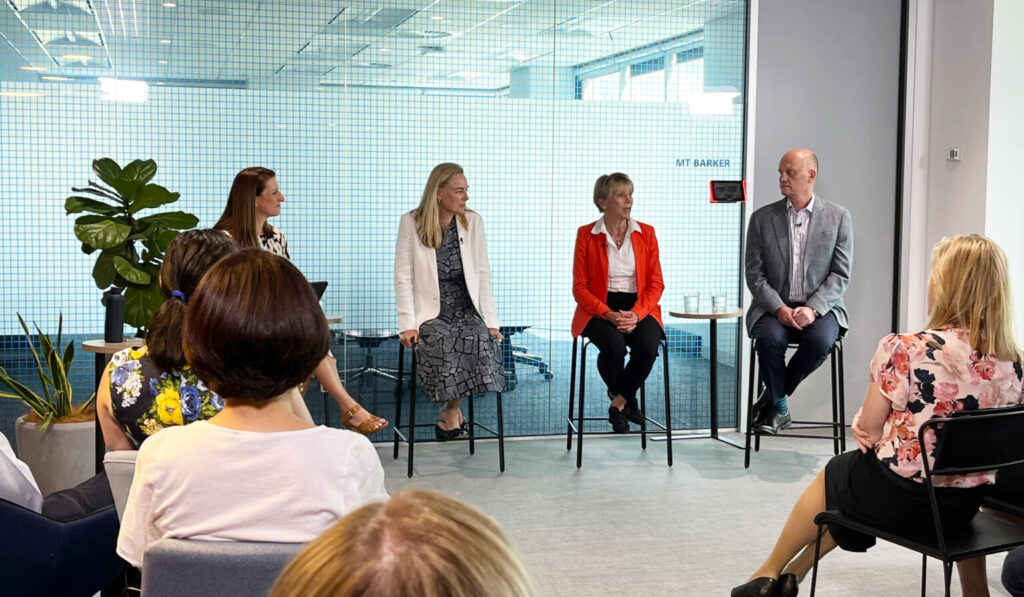To celebrate International Women’s Day 2024, we sat down with two of our newest board members, Dr Adelle Howse and Christy Boyce, Non-Executive Directors on BAI’s Board of Directors.
Having joined the BAI Communications Board in July 2023, Adelle and Christy bring deep industry and leadership experience to BAI, providing strategic advice and counsel for the business as it continues its growth trajectory.
Adelle brings extensive executive and non-executive experience to the BAI Board in strategy, M&A, and high-performance culture, from a variety of industry sectors including digital infrastructure, construction, energy, and resources. She is currently an independent Non-Executive Director for Downer EDI Limited, a Non-Executive Director for Sydney Desalination Plant, an independent Non-Executive Director at Macquarie Technology Group and she is also an advisory board member for a number of startups and SMEs.
Christy is an accomplished strategic advisor and experienced director, having worked with senior leadership across a range of multinational and Australian-based corporations. As a Partner at McKinsey & Co, she co-led the Asia Pacific Telecommunications Practice and as Head of Industry Engagement, she was a key executive in the establishment of NBN. Christy currently serves as a Non-Executive Director for CSR Limited and JB Hi-Fi and is Chair of the SCEGGS (Darlinghurst) Trust.
Hear from Adelle and Christy below to gain invaluable insight into the important lessons they have learnt over the course of their career and the advice they have for women in the industry as we work to #inspireinclusion.
Reflecting on the theme for International Women’s Day in 2024, why do you think it is important to #inspireinclusion? How do you #inspireinclusion?
Both Adelle and Christy highlight the crucial role of diversity and inclusion in enhancing business outcomes, and the importance of intentional practices to achieve these benefits.
“Inclusion is key to driving business outcomes. Diverse teams bring a diverse perspective, leading to more effective decision-making, planning, and risk management. Inclusion widens our talent pool, meaning we increase our chances of finding individuals with the skill sets we need. It is also the right thing to do,” says Christy.
Adelle adds, “inclusive environments promote collaboration and teamwork. When individuals feel included and valued, they are more likely to work together, share knowledge, and support one another. This can lead to stronger relationships, increased productivity, and the ability to tackle complex challenges more effectively.”
Both leaders echo each other’s sentiments on creating an environment where everyone can contribute to the best of their ability, which they say requires intentional effort and deliberate focus when recruiting to foster a culture of inclusion and provide flexibility in working conditions.
What advice would you have for women starting out in business, particularly communications and technology?
Both Christy and Adelle advocate for self-investment, enjoyment in one’s career, and assertiveness, emphasising that success is ingrained in personal development and strategic contribution.
“Invest in yourself,” Christy advises. “This means building your subject matter expertise and your ability to collaborate effectively within a team. It’s crucial to demonstrate your capacity to deliver results. Seek out mentors and sponsors who can guide you, both from within your field and beyond. There will be some that look like you and some that do not.”
“I agree with everything Christy said,” says Adelle. “Most importantly, believe in yourself and have confidence that you are enough. Don’t be intimidated by overly outgoing and extroverted types. Don’t get lost in minor issues – focus on the strategic, bigger things that will have an impact and allow you to make your mark. Learn to be assertive and don’t stand back when you have valuable and important knowledge to share.”
“Don’t shy away from challenges; back yourself. And importantly, find enjoyment in your work.” Christy adds.
What have you noticed has changed for women in the workplace over the course of your career?
While acknowledging progress, both Christy and Adelle point to the ongoing need for improvement, particularly in achieving gender parity at senior leadership levels, with Adelle sharing “the increased transparency around gender disparities, like the Workplace Gender Equality Agency (WEGA) pay gap analysis, means we can justify more focus, yet there’s much work to be done.”
Reflecting on her own career experience, Christy observes, “I have seen a lot of change for women in the workplace, mostly for the better. I was lucky that there were women in senior roles in my first job. Though my performance was valued, it could be quite the ‘boys club’ at times, but there were enough great women and supportive men that it didn’t matter. However, this representation was not common across all sectors.”
Adelle acknowledges that whilst she has seen progress it has been slow “this is particularly evident in senior leadership roles.”
What do you see as the current challenges for women in the workplace?
Recognising that advancements have been made, both Christy and Adelle highlight that challenges persist, particularly in leadership diversity and acceptance of different leadership styles.
“I think it’s a much more supportive and welcoming environment than it was 30 years ago. But people naturally gravitate towards those they feel comfortable with, which can create barriers. The good news is that we’ve had over 30 years of women in senior roles and a critical mass of women across the entire workplace.” Christy shares.
Adelle, whilst acknowledging the progress made at C-level, emphasises the gender disparity in senior leadership roles. “While we’ve seen advancements at the board level, this is taking those individuals away from senior management roles, creating a new challenge – which is to continue to fill these roles with women. Whilst we are seeing some progress in diversity at board level – we aren’t seeing this reflected for the chair role. There is also still a small percentage – less than 10% of women in Chief Executive Officer (CEO) positions for example.”
Adelle believes that differing leadership styles between genders may put women at a disadvantage in being considered for these senior roles. “We need to raise more awareness of different leadership styles and share examples of successful female CEOs as role models for others to aspire to.”
Christy finishes with some advice for women currently navigating these challenges in today’s workforce. “You need to try and find your people. Those who you can trust when you have a challenge – whether it be technical, or team related. When you feel you are not getting a fair go, speak up – obviously in a constructive manner – assume good intent and seek to understand. Always push for a solution.”
What have you seen that has been effective in driving action towards gender parity in the workplace?
Both suggest that driving action requires intentional supportive actions, such as flexible work across all levels of an organisation and the role of mentorship and leadership commitment, as crucial to driving gender parity.
“Women supporting women – up, down, and sideways and when men show genuine curiosity about women’s experiences and what motivates them to stay. More flexible arrangements – and men utilising them too. Senior leaders both male and female actively looking to mentor and support people who ‘don’t look like them’” are the drivers that Christy believes are making effective strides towards gender parity. Adelle agrees “driving action requires genuine intention from the Board and the CEO – top down.”
BAI’s female representation is steadily increasing, and we are in a leading position in terms of our pay equity. What more can we do to attract and retain a more diverse workforce?
Christy and Adelle both agree that an inclusive and appealing workplace culture is essential for attracting and retaining a diverse and dynamic workforce, highlighting the importance of feedback and action in these efforts.
Christy sees the key strategies as “being known as a great place to work, modelling inclusion at all levels and continuing to demonstrate that BAI is a meritocracy. We do this through actively listening to the experiences of others across the business.”
“Including positive bias in our recruitment practices to help increase participation of women across our organisation and asking our female employees what we can do better to promote new roles within their networks,” says Adelle.
What are the key drivers for influencing culture, especially in an organisation like BAI?
Visible diversity in leadership and open dialogue are the key critical drivers, identified by both leaders, for fostering an inclusive organisational culture. “Without representation, aspiration lacks inspiration ‘you can’t be, what you can’t see’, so it’s important to ensure the team see people from different backgrounds succeeding in the organisation. Be willing to have the difficult conversation without defensiveness – and share these stories,” Christy says.
Adelle expands on this shared belief. “Leadership teams must model the behaviours the organisation is aspiring to, in order to shape the culture. The mission, vision, and values must provide clear, meaningful, and aligned statements to inspire the desired culture, and then we need to hire people who embody it.”
Who are some women that inspire you?
Drawing from their unique and individual experiences, both leaders’ inspirations reflect a deep appreciation for women who have broken barriers and used their platforms to advocate change, showcasing the wide-ranging impact of female leadership.
Adelle: “I have been inspired by maths Professors Anne Street and Diane Donovan. Ada Lovelace is a great inspiration, allegedly the world’s first computer programmer and her notes were used by Alan Turing. I absolutely look up to Helen Wiseman who is a wonderful example of a female dedicated to supporting women with purpose.
Christy: “I’m a bit of a fan girl of Melinda Gates and Michelle Obama. They used their platforms to address areas where women are most disadvantaged and to really embed equality in the early years. I also loved both their books – ‘The Moment of Lift’ and ‘Becoming.’ I am inspired seeing competent women; Julia Gillard – irrespective of your politics – got a lot done in her time as prime minister. I love that the current President of the European Union (EU) and the Managing Director of the International Money Fund (IMF) are both women. Closer to home, I love that the Teals have shown a unique way to approach politics – working with their communities, championing transparency, and delivering on their individual passion issues.”
The rich insights Christy and Adelle have gained from their experiences demonstrates a shared commitment to inclusion, empowerment, and leadership. Their complementary perspectives highlight the progress made and the ongoing efforts required to achieve gender parity and cultivate an inclusive workplace.






